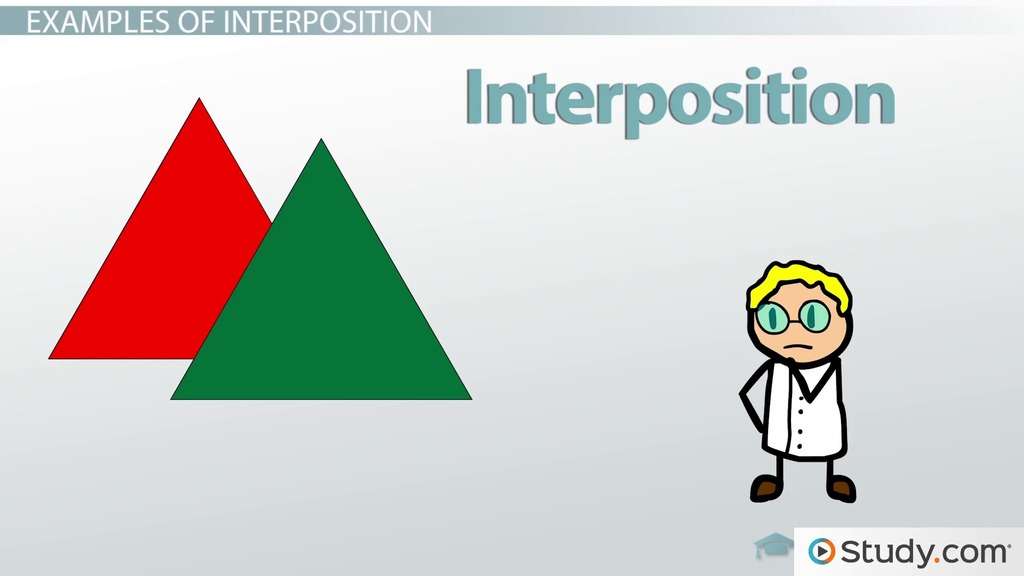Take a look at these triangles. This image contains an example of an interposition.
Which of the two triangles in this picture do you think is the closest to you? Which one do you think is further away?
We all know what a triangle looks like. It has three corners and three sides. You can see the full green triangle, but the red triangle is partially covered. We would judge the green triangle as being closer and the red triangle as being further away, though in reality, both triangles are the same distance from you as measured by the distance between your eyes and the screen. It is the overlap that causes you to perceive depth in this image.
Now, look at these circles.
Which one of the circles is closest to you? Because we know what circles look like and we only see part of the yellow circle, we judge the blue circle as being closer.
Now see if you can tell how far the circles are away from each other. It is impossible to tell the distance between the two circles. That is because interposition only gives us information on the depth of the circles in relation to each other. Interposition provides no information regarding the absolute depth.
Lesson Summary
Interposition is a monocular cue that occurs when one object obscures another, which causes the object that is partially covered to appear more distant. Because we only see part of what we expect, we interpret the object that is partially covered as being further away. The major assumption of interposition is that near objects always at least partially overlap objects that are further away.
Learning Outcomes
As you finish this lesson, your goal should be to:
- Remember what interposition is
- Compare monocular and binocular cues
- Examine examples of interposition
Monocular cues are information that people use to make judgments about depth and distance in their environment based on the visual field of a single eye. The term ‘mono’ is used because these types of cues can be perceived in either the left or the right field of vision; both eyes are not needed to perceive these cues. Someone can close one of their eyes and still detect monocular cues. Interposition is considered a monocular cue because it allows individuals to obtain information about depth perception from the environment.
Other examples of monocular cues include:
Relative size: Objects that appear smaller give the perception of being father away than objects that appear larger. This is because objects become smaller as they move away from the viewer. This is called size constancy.
Linear perspective: Parallel lines appear to converge as they move farther away.
Light as a cue: Shadows often give cues about distance and depth perception. For example, artists often use lighting and shadows in paintings to portray distance and depth.
Monocular movement parallax: Objects at different distances in the environment appear to move at different speeds when someone is in motion. For example, when someone turns their head, objects that are closer appear to move in the opposite direction and farther objects move in the same direction as the head movement.
Binocular Cues in Perception
Binocular cues are information that people gather from their environment about distance and depth based on both fields of vision. It is also referred to as stereopsis, and it is considered to be a stronger cue of depth perception than cues perceived with only one field of vision. The left and right fields of vision provide slightly different visual images. This is referred to as retinal disparity or binocular disparity. Binocular vision produces two slightly different retinal images because of the different position and angle of both eyes. The two retinal images are quickly and automatically compared and combined during visual processing, which provides the individual with information about depth perception. Retinal disparity can easily be demonstrated by focusing on one object with both eyes and then closing each eye one at a time. When this is done, the object will appear to move slightly.
Interposition Examples
Interposition is a very common visual experience that people see every day. Here are a few interposition examples:
Interposition Example 1
Example 1 – Interposition is often used in art.

As previously mentioned, interposition is often used in art. Example 1 is a painting of a three-dimensional landscape. In the painting, the farmer obscures part of the hill in the background, which gives the perception that it is farther away. There are trees in the image that partially obscure the house that appears to be farther in the background. And finally, some of the trees overlap the mountains, giving the perception that the mountains are located much farther away in the distance. It’s worth noting that depth and distance can still be perceived without the use of interposition in this painting due to other perceptual cues, such as relative size and shadowing.
Interposition Example 2
Example 2 – Interposition can be seen in crowded streets.

Example 2 illustrates interposition as is often seen in populated city environments. In this photograph, people appear to be farther away due to being partially obscured by other people who appear to be closer to the viewer. The person’s head in the lower left side of the picture appears to be the closest person and it partially obscures several people that appear farther away. Also, people in the crowd partially obscure things in the background, such as the buildings and the trolley. Once again, there are multiple visual cues that give the perception of depth and distance, but interposition is very noticeable in this image.
Lesson Summary
Interposition is a type of monocular cue in which one object partially obscures or covers another object, giving the perception the object that is partially covered is farther away. Interposition provides people with the feeling that they are perceiving depth. Objects in the real world that are farther away are often partially obscured by objects that are closer to the viewer.
Monocular cues are information that people use to make judgments about distance in their environment based on the visual field of a single eye. They can be perceived in either the left or the right field of vision. Binocular cues about distance and depth are gathered from their environment using both fields of vision; this is also referred to as stereopsis. Interposition is something that people encounter frequently, and it is often used in art to give the perception of depth and distance. Interposition examples include depth and distance portrayed in art and seeing people in a crowded street.
Interposition Psychology
Interposition Psychology Definition
According to an Oxford Dictionary, “Interposition Psychology” is the placement of monocular cues of visual depth perception and overlapping another object. The overlapping object looks closer than the monocular cue, which is the backend. When one object blocks the path of another, the blocked object is perceived as more distant.
Interposition is the act of overlapping two objects to give the illusion of depth. Interposition is one of the Monocular Cues For Depth Perception. Monocular cues are formed when one object partially covers another, known as interposition or overlapping. By doing so, it appears as if the object that is being covered is the one that is further away. Any stimulus related to depth perception which can be perceived with one eye alone is a monocular cue. As opposed to binocular cues, in which the depth is perceived by using both eyes at the same time.
Interposition Psychology Example

Look at these two triangles, Green and Red. The green triangle is fully visible, but the red triangle is partially hidden. Green triangles appear closer and red triangles appear further away, despite the fact that, as measured by the distance between your eyes and the screen, both triangles are at the same distance from you. In this image, it is the overlap that gives the impression of depth.
Depth Perception
Depth perception is the ability to perceive the world in three dimensions (3D) and to judge the distance of objects. Your brain creates 3D images by combining images from each eye and combining them to form one image. Your eyes are able to determine the distance between objects, as well as whether something is far away or close to you, by depth perception.
A variety of depth cues contribute to depth perception. They can be categorized as binocular cues to represent information received from both eyes in three dimensions, and monocular cues to represent information received in only two dimensions and observed by only one eye.
Monocular Cues For Depth Perception
-
Interposition
-
Linear Perspective
-
Aerial Perspective
-
Retinal Image
-
Texture Gradient
-
Shading
-
Movement Cues
-
Accommodation
Binocular Cues For Depth Perception
-
Convergence
-
Retinal disparity
Similarly, You may Also like:
Share this:
-
More




